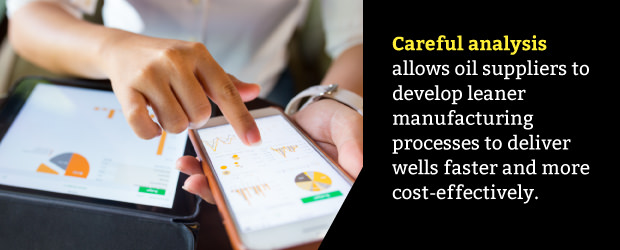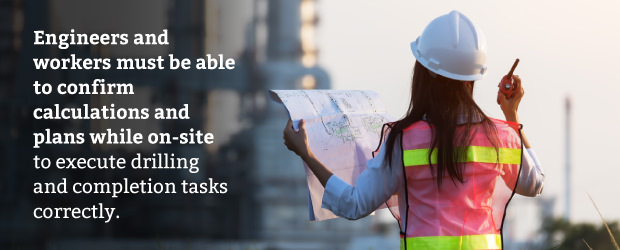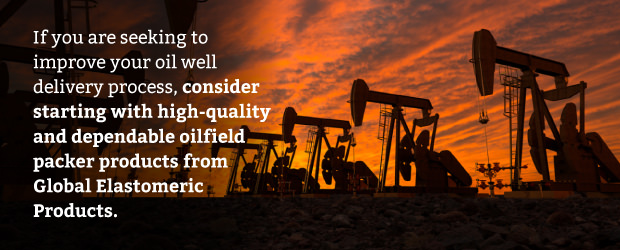Common Causes of Well Delivery Delay

Oil & Gas Journal predicts that total spending for exploration, drilling and production will reach nearly $152 billion in 2019. While this 2 percent increase shows a significant deceleration from the 23 percent increase in 2018, oil companies are still seeking ways to reduce spending and create more efficient processes. Delays in oil well delivery are a major factor in excess upstream spending for oil suppliers. Oil well delivery delays can disrupt revenue flow and necessitate additional spending for resources, equipment and labor.
As oil companies target new assets and plan for future oil wells, they must take steps to eliminate inefficiencies and optimize the oil well delivery process. In this article, we will examine the common causes of oil well delivery delays and explore solutions for minimizing or eliminating costly stalls in oil well planning, execution and completion.
What Is the Well Delivery Process?
The oil well delivery process outlines the series of activities that are necessary to plan and execute the drilling and completion of an oil well. An effective oil well delivery process accounts for the multitude of factors involved in oil well delivery to plan for any risks and uncertainties that may arise. By relying on a well-defined and efficient process, oil suppliers can avoid delays and increase their revenue return through timely well completion.
Oil well delivery begins with comprehensive planning and ends with thorough analysis to further improve the well delivery process for future drilling projects. These are the basic steps of oil well delivery:
- Goal identification: Oil well delivery starts with a clear understanding of the objectives of the well, whether it is for production or exploration. Oil suppliers set goals for the asset and a proposed timeline for oil well completion.
- Well planning: During the planning stage, the geologic target and surface drilling point are determined and engineers plan the best trajectory between these points based on nearby wells and geological formations. A step-by-step plan for well execution is created, detailing all essential elements of well delivery — including personnel, equipment, design creation, resource allocation and more.
- Drilling: After extensive planning, the well is drilled using a drilling rig and steel casing is placed into the hole.
- Completion: Oil well completion involves preparing the well to produce oil by drilling small holes in the casing to allow oil to flow into the tubing or installing sand screens in open hole production. In wells that do not have sufficient subsurface pressure to push oil and gas to the surface naturally, an artificial lift method may also be installed as part of the well completion process.
- Production: Once the oil well is completed, production begins. Drilling equipment is removed from the wellbore, and the top of the well is fitted with valves to regulate the pressure and flow. The outlet valve allows oil to be distributed through pipelines to refineries, oil export terminals and other destinations.
- Process improvement: After oil well delivery is complete, the final step is to analyze the well execution and production to identify areas for process improvement in the future. Careful analysis allows oil suppliers to develop leaner manufacturing processes to deliver wells faster and more cost-effectively.

Oil well delivery delays are possible at any step of this process, from planning to extraction. Delays can be caused by everything from poor communication between stakeholders during planning to equipment failure or malfunction during drilling.
Any delay in oil well delivery can be a serious hit to an oil supplier's bottom line. In addition to delaying revenue, stalls in oil well delivery can create additional expenses, such as if equipment rentals must be extended to make up for a delay or employees must be paid overtime to finish a well on schedule. Well delivery delays can also damage relationships with stakeholders and clients who depend on oil suppliers for timely delivery of product.
Causes of Oil Well Delivery Delay
Understanding the common causes of oil well delivery delay allows oil suppliers to anticipate potential problems and take actions to prevent them. Here are a few of the primary factors that can cause stalls in oil well delivery:
1. Human Error
Human error can occur at nearly any stage of oil well delivery and at every level of personnel — from expert geoscientists to workers out on the rig. Mistakes can occur during drilling execution if staff are not properly trained to operate equipment or during oil well planning, such as mistakes in data entry or errors in calculations. One small incorrect number can cause a serious mistake and result in a long delay of well delivery.
Many oil suppliers still depend on manual systems that increase the risk of human error during data entry and transfer. Personnel must transfer data from one application to another as they progress through different stages of the well delivery process. When managing huge volumes of data and calculations in a manual system, human errors are bound to occur. To prevent human errors in data entry, oil suppliers can employ automated systems that streamline data transfer and protect against costly mistakes. Automated data management systems can detect errors and ensure data is more secure and more accurate.
Oil suppliers can also protect against human error during well delivery by investing in effective onboarding and training programs. Over the past several years, the oil and gas industry has experienced a shift in the workforce as older, skilled workers retire and new employees enter the field. Research by the American Petroleum Institute (API) projects that Millennials will make up 41 percent of the workforce in oil and natural gas and petrochemical industries by 2025.
Although this younger workforce boasts higher education levels and greater diversity than previous generations, effective training is essential to account for less on-the-job experience. Oil companies must employ comprehensive on-boarding and training programs that stress the importance of preventing errors in oil well planning, drilling and completion. With the potential for more than 1.9 million new jobs in the oil and natural gas industry by 2035, oil suppliers must seek skilled and dependable workers to reduce human mistakes in oil well delivery.
2. Data Accessibility
The oil well delivery process depends on a series of tasks that build upon one another. In many instances, one team cannot complete a step in the process until they receive data or calculations from another department. Oil well delivery delays can occur when team members must wait for data to be transferred or must track down the data they need from other departments. When data is not readily accessible, this can create bottlenecks in the oil well delivery process and prevent employees from managing their time effectively.
Oil well planning involves coordination and communication between various stakeholders and suppliers. To complete an oil well on schedule, all relevant parties must be able to access data for review, analysis and approval. Lack of data visibility can significantly delay the oil well delivery process and impair effective decision-making. During the production stage, data visibility and accessibility are even more important to manage assets effectively.

Data accessibility in the field is also a critical component of successful oil well delivery. Engineers and workers must be able to confirm calculations and plans while on-site to execute drilling and completion tasks correctly. Many oil suppliers still rely on paper-based systems that may not always reflect the most up-to-date data and figures. Outdated or incomplete data can result in mistakes in oil well delivery or put work on hold until data can be verified.
Oil suppliers can achieve greater data accessibility through cloud-based data management systems that allow streamlined information transfer and complete data visibility. Data management systems for oil well delivery allow stakeholders in remote locations to collaborate effectively and workers to access crucial data from mobile devices while on job sites. Figures and calculations can be updated in real-time to prevent costly mistakes or delays during oil well planning and execution.
For companies that are drilling hundreds or thousands of wells each year, effective data management becomes even more crucial. Companies must employ effective methods to track and exchange data between various entities to advance the well delivery process through its many development stages.
3. Lack of Planning
Effective oil well delivery requires extensive planning that includes risk assessment and anticipates any potential challenges. Because oil well delivery involves many interconnected steps, any small error or change in one area can have a large ripple effect on numerous others. Making a small adjustment during the drilling or completion stage can cause lengthy delays as calculations must be reworked or equipment changed.
For example, when planning the trajectory for an oil well, engineers and geoscientists must consider clearance to any surrounding wells and faults, plan for possible interference with future wells, determine the ideal angle for drilling and work around any geological formations that may be more difficult to drill through. Scientists then predict the properties of the subsurface to select the correct drill bits and drilling fluid and to design the casing and bottom hole assembly. Trajectory plans and designs often go through several revisions before they are finalized.
Rushing through the planning stages for oil well delivery can cause costly problems during well execution and completion. If drilling teams encounter a different substrate material than anticipated, they may need to change the trajectory of the well or use different drilling equipment. If casing design is flawed, well completion may be delayed until an effective casing can be installed. However, by anticipating potential problems up front and planning ahead, oil suppliers can have the right equipment available to keep oil well delivery on track.
Another effective strategy to reduce delays due to ineffective planning is to establish a standardized well delivery process. Although each project will have unique requirements, oil suppliers can strive to create more stable processes for long-term planning. By solidifying well designs and drilling plans in advance rather than making adjustments last-minute, companies can manage their supply chain more effectively and enjoy greater predictability in production. Stable well delivery plans allow oil companies to optimize logistics for specialized equipment and better plan for rig allocation.
Companies drilling a series of wells can also reduce oil well delivery delays by planning for similar projects to be executed consecutively. When workers are engaged in repetitive jobs, they require less learning for each new project and can complete drilling tasks more efficiently. By grouping similar jobs, companies also reduce the likelihood of human error.
4. Lack of Analysis
Post-process analysis is a crucial step in effective well delivery and can significantly reduce oil well delivery delays in the future. After each well completion, teams should perform a complete analysis to identify process inefficiencies and areas for improvement. Without analysis, teams are likely to repeat the same mistakes or continue to operate with the same inefficient processes. However, by tracking performance metrics across all areas of oil well delivery, oil suppliers can gain insights that better inform decision-making in the future.
By analyzing data from previous oil well projects, teams may even be able to predict when an incident is imminent and intervene to prevent it. Past project data may reveal patterns of processes or actions that resulted in delays or downtime. By identifying data connected to mistakes or delays, teams can actively avoid these scenarios in the future.

Modern technology can support predictive analytics for oil well delivery through intelligent data collection and analysis. Technology can be used to collect real-time data during drilling and identify patterns that lead to failures. Advances in artificial intelligence for drilling data analysis have also produced technology that can interpret unstructured well planning data to provide valuable insights into potential risks.
5. Product Failure
During the oil well delivery process, workers rely on specialized tools and equipment to get the job done. When executing well drilling and completion tasks, product failure or malfunction can cause significant stalls in oil well delivery — and may even result in fatal accidents. Product failure can occur due to defects, poor product design or low-quality equipment. Product failure may also result from the misuse of equipment by under-trained workers.
For oil well projects that require custom equipment or products, companies must choose a trustworthy supplier to engineer components that meet their precise specifications. Because custom equipment generally has longer lead times than standard parts, it is essential that specialized parts are engineered correctly the first time to prevent significant delays in oil well delivery.
Product defects can also cause unnecessary delays and waste valuable resources and time. Workers must expend time to dispose of defective products and wait for new products to arrive before work can continue. By choosing a high-quality supplier from the start, oil companies can avoid costly delays due to product failure. Well-designed and defect-free equipment will result in a more efficient oil well delivery process and faster well completion.
Oil companies can also face challenges when coordinating with multiple suppliers for products they need to complete oil well drilling projects. If one supplier is not reliable and does not deliver products on time, the entire process will be delayed. However, by working with a single supplier for all oil well drilling products, companies can streamline their supply chain and rely on high-quality products to complete oil well delivery without costly delays.
High-Quality Rubber Products From Global Elastomeric Products
Oil well delivery delays can be caused by a range of issues — from human errors to problems in data management. Insufficient planning can put projects behind schedule and low-quality products can lead to project stalls that waste time and resources. If you are seeking to improve your oil well delivery process, consider starting with high-quality and dependable oilfield packer products from Global Elastomeric Products.

Global Elastomeric Products has produced reliable rubber products for the oil and gas industry since 1963 and offers a wide assortment of elastomeric products including packer cups, valve seals and shear out joints. For specialized oil well projects, Global Elastomeric Products can provide custom rubber molded products to match your unique design needs. Contact Global Elastomeric Products for more information about how our rubber oilfield equipment can reduce oil well delivery days to boost your revenue and improve your well delivery process.




